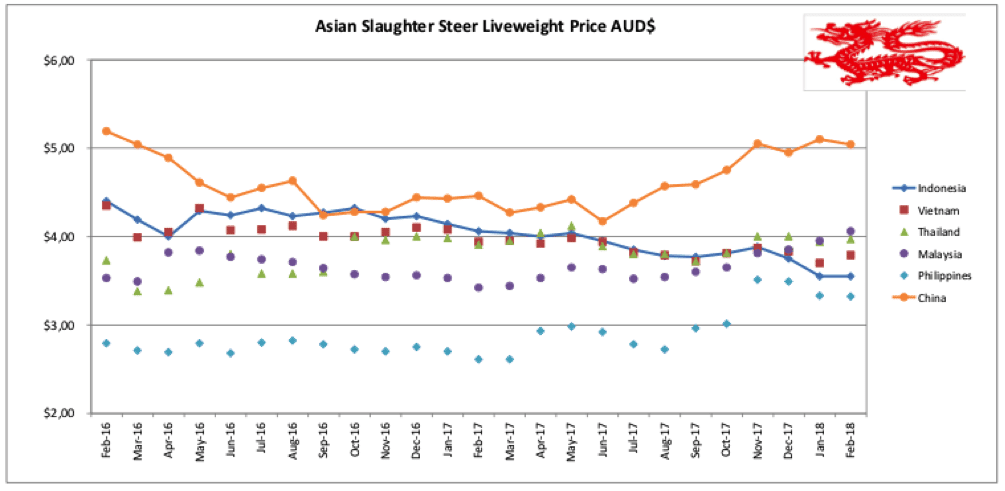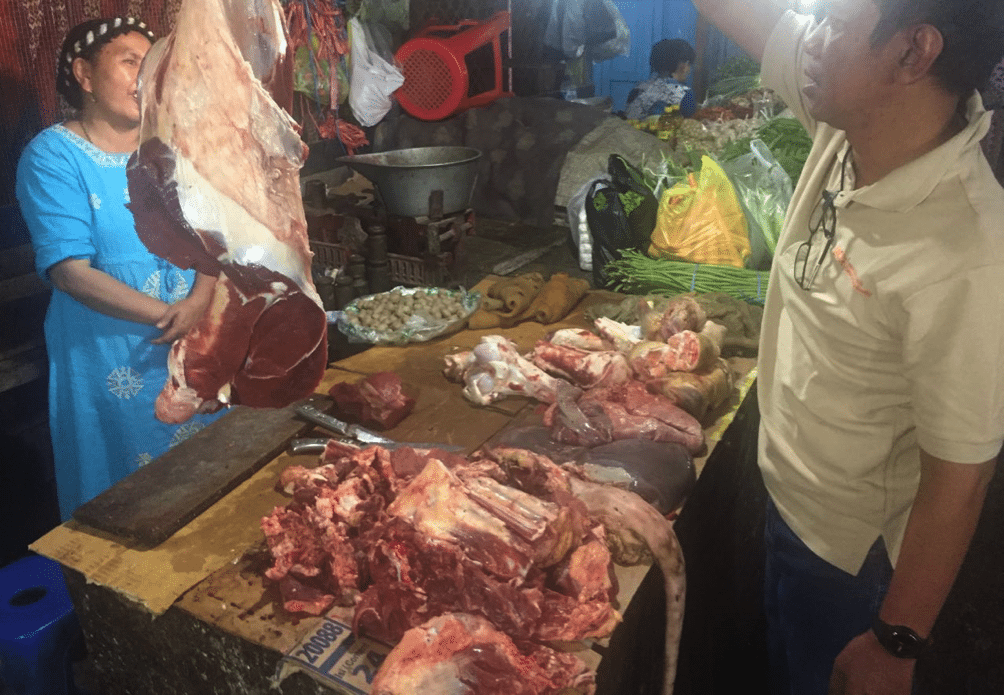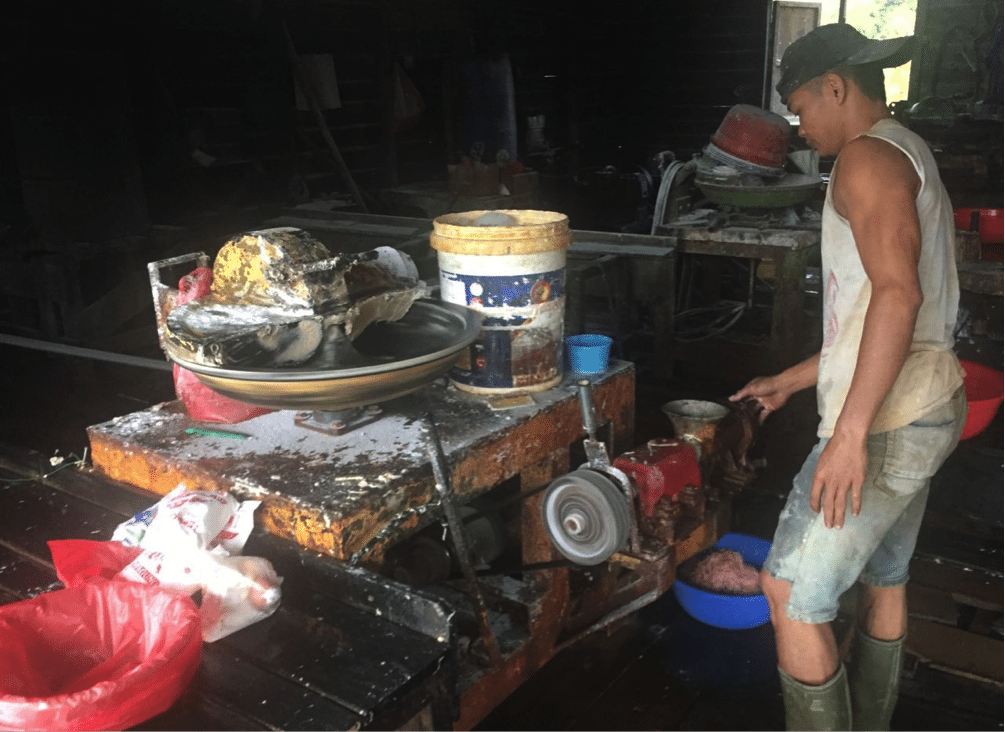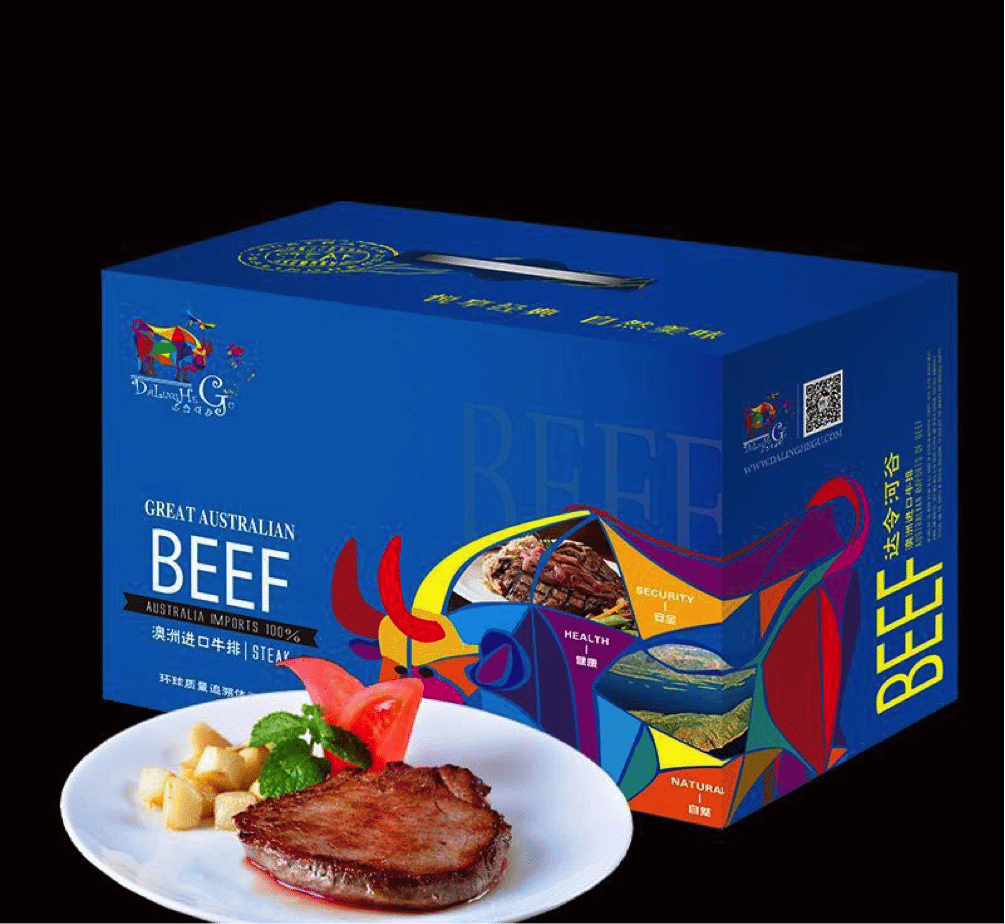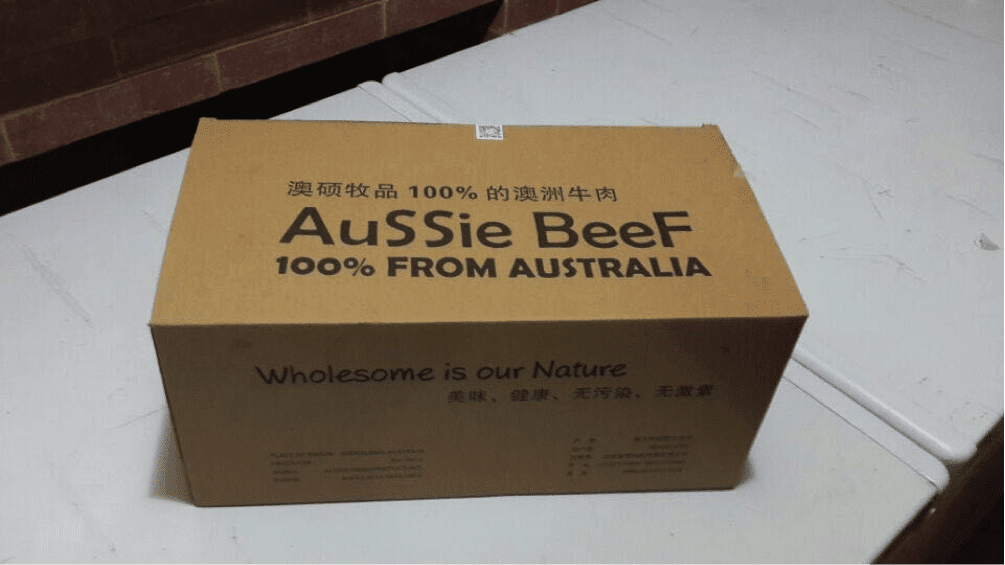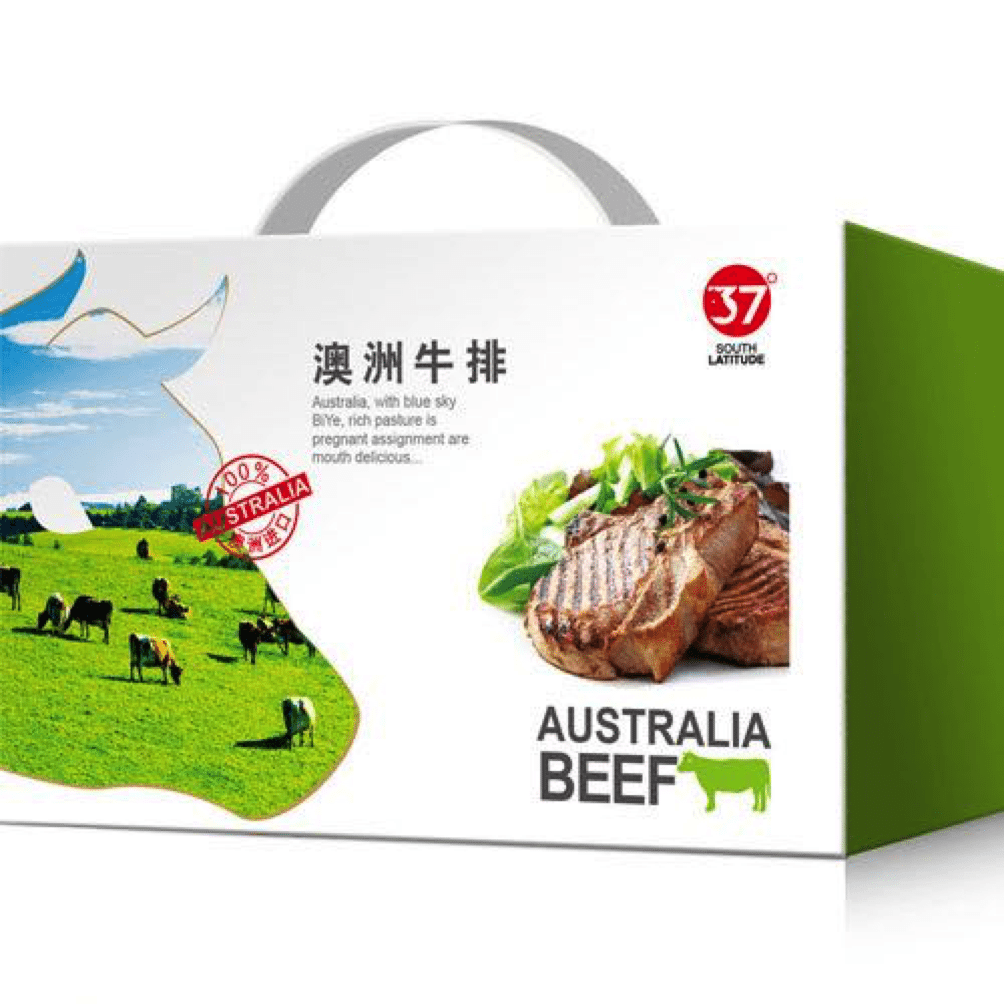
For the Bahasa Indonesia version of this report click here (Untuk versi bahasa Indonesia dari laporan ini klik di sini)
Indonesia : Slaughter Steers AUD $3.55 / kg live weight (Rp 10,700 = $1AUD)
Prices remain static from last month with perhaps a little more credit being offered to move cattle without dropping the price even further.
Rp37,000 remains the lowest discount price reported to date so I am maintaining Rp38,000 as the indicator price for February.
The stubbornly high Aussie $ is not helping while feeder cattle prices across the north remain at around the AUD$3.20 area for the moment. Importers were hopeful of a dip in prices later in March/April as the northern mustering season commences but the recent useful rains are likely to limit the fall in prices to a relatively minor level.
Many feedlots are holding excessive numbers of over fat cattle due to slow sales so this is likely to maintain the downward pressure on slaughter cattle prices later in March.
Feedlot numbers continue to shrink but it appears that the numbers on hand are still way above the needs of the market so many importers are planning to continue to reduce their inventories further through reduced imports for the foreseeable future.
If Indian buffalo has taken about half the market then live cattle inventories should logically find a new equilibrium after a similar contraction. With the rough average of close to 600,000 head of feeders imported per year for the last decade, this contraction is likely to find its new sustainable level at an annual figure in the region of 300,000 head or less depending on any further penetration of the Indian and other frozen products.
I note with interest that ABARES (Australian Bureau of Agricultural and Resource Economics and Sciences) predicted at its recent 2018 Outlook conference in Canberra that live exports from Australia to Indonesia will grow in the next few years:
“ABARES suggests import demand in Indonesia is strong, supported by growth in incomes, population and urbanisation, as well as a growing preference for diversified diets. Constrained growth in Indonesian beef production is also supporting import demand because strong prices provide local producers with an incentive to maintain a high rate of turn-off, restricting growth in the Indonesian herd.”
Their demand side comments above are spot on but they appear to have forgotten about the massive influx of Indian beef which is capturing in the order of 50 percent of the import market (live and box beef).
This huge loss of market share is already a very unhappy reality for Australian exporters so how anyone can predict that exports will grow strongly is a mystery.
For the Australian producers prospective, I hope they are right.
During February, Bulog announced that the Trade Ministry had released import permits for 100,000 tons of Indian buffalo beef for 2018.
The official figures I have obtained indicate that only about 36,000 tons was actually consumed during the whole of 2017 (while 2017 permits were for 55,000 tons). The logic from the government was that this high volume of Indian product would help push the price of beef down.
If the country could only consume less than 40,000 tons in 2017, I am curious to see what factors might emerge to increase this level of consumption by more than double for 2018.
The one thing that Indian product has not done is reduced retail prices as most of the product has gone into manufacturing and low end food service with the output products selling for retail prices just the same as before Indian beef was introduced.
All the margins have been captured by traders and manufacturers with nothing left for the consumer. In a similar way the price of live slaughter cattle has tumbled from Rp42,500 per kg live weight in September 2016 (when Indian beef arrived) to Rp38,000 today, a fall of about 10.5% as a result of the reduced demand by butchers.
The price of knuckle in the wet market was Rp135,000 in September 2016 with very similar rates offered today, so effectively no reduction in the rate to consumers as the butchers and traders have captured the additional margins. Traders and retailers get the gold while the Government policies and consumers get nothing.
Bali appears to be bouncing back from the disastrous crash in visitor numbers associated with flight cancellations due to the Mt Agung volcanic eruptions. The mountain has been behaving itself for more than a month now with tourist numbers rising accordingly. Hopefully Mt Agung will go back to sleep on a long term basis so everyone, especially those living close to the volcano, can get their lives back to normal.
Pangkalanbun is a smallish city (about 200,000 population) on the south west coast of Kalimantan. I visited there last week and made an early trip to the largest wet market to see how the beef business was going far away from the major cities.
Essentially it is business as usual just like the rest of Indonesia with knuckle selling for between 120 and 130,000 Rp per kg. The butchers we spoke to explained that there are about 10 – 12 head per day slaughtered locally with the origin of the cattle mainly from East Java via small boats and ferries from Surabaya and Madura.
Astra, one of the largest palm plantation companies, has a cattle project in this area and they also supply some of the cattle that end up in this local market.
The lady in the photo below presents a broad offering of beef products at her stall including her own beef bakso balls (upper middle of the photo in the aluminium foil). She makes the bakso with the help of the bakso ball processors that are present in most larger Indonesian markets.
I am preparing a full story on the making of bakso to be published later this month.
Beef, bones, feet, skin, tripe, liver, lung, tail and her own beef bakso balls.
Photo below: Stainless steel bakso grinding bowl, belt driven by a diesel motor. In this photo the operator is first mincing some chicken to be placed in the larger mixing/grinding bowl where the meat and other ingredients will be blended into a thick paste. The main ingredients other than meat are tapioca flour and a large variety of herbs and spices. The bucket contains ice blocks which are thrown into the mix to prevent the grinding process from getting too hot as well as providing moisture for the structure of the balls.
Vietnam : Slaughter Steers AUD $3.79 / kg (VND17,700 to $1AUD)
No significant change in slaughter cattle prices with D67,000 remaining about the middle of the range for fat steers in Ho Chi Minh City.
Bulls in the south can make up to D72,000 while in the north the rates remain about 1000 Dong per kg higher in all categories except for fat heifers which attract a rate of D64,000 in both northern and southern markets. Feedlots remain at around 80% capacity. Meat prices in the wet and super markets are steady on previous rates.
It is interesting to note that most categories of stock and meat products have maintained their prices from previous months despite the main holiday festival of Tet occurring in the middle of the month. This does not provide much confidence for the maintenance of import volumes during the rest of 2018.
Thailand : Slaughter Steers AUD $3.97 / kg (Baht 24.7 to $1AUD)
The slaughter market appears to have been weakening during February with my indicator slaughter steer price slipping a little from Baht 100 to 98. My advice is that the Thai government has been aggressively testing slaughter cattle for Beta Agonists with the outcome being that many cattle have been blocked from export opportunities. These cattle have then been redirected back to the domestic market creating some oversupply issues.
Malaysia : Slaughter Steers AUD $4.06 per / kg (RM3.07 to $1 AUD)
This apparent price rise is purely due to the surprise strengthening of the Ringgit. Slaughter cattle numbers in Malaysia are so low that it is very hard to even find a quote so the rates I provide are a general indicator at best with live cattle prices likely vary widely in different locations around the country.
Philippines : Slaughter Cattle AUD $3.32 / kg (Peso 40.7 to AUD$1)
Prices fairly steady across the board. The farmers continue to be blessed with favourable seasons but this has meant that the tourist industry has suffered from damaging storms and higher than usual rainfall, flooding etc. Rising fuel prices are also putting new financial pressures on some industry sectors. On balance though, the economy continues in a positive direction.
China: Slaughter Cattle AUD $5.04 / kg (RMB 4.96 = AUD$1)
Slaughter cattle prices remain firm in both key cities with the Beijing live price at Y25 and the Shanghai price at Y26 per kg.
Only 12 months ago, the price of slaughter steers in Shanghai was AUD$3.11. Today’s Shanghai rate of 26 converts to $5.24. Even allowing for some of this increase to be due to currency movements, this rise of almost 70% is quite spectacular.
It is well known that many abattoirs in China are either under utilized or not working at all due to a shortage of suitable stock. There is also no argument that the Chinese economy is continuing to grow with increased demand a direct consequence of more Chinese being able to afford beef than in the past.
With supply and demand pushing the price of local live cattle ever higher, the Chinese government must be under great pressure to modify the health protocol and open the market to commercially viable live imports.
The scandals in the Chinese meat industry just don’t stop with a new crackdown on the retailing of dead and diseased pigs.
Authorities in a key meat producing area of the Shandong province of Eastern China have shut 26 slaughtering facilities with media reports of similar scams from other parts of the country.
The term “dead and diseased pigs” has spread like wild fire through the Chinese media and government regulatory services.
The list of misbehaviour seems endless with fake drugs, poisonous additives, antibiotic contamination, meat substitution (cheaper pork substituted for lamb), back yard slaughtering and ineffective traceability all under the spotlight.
Regional governments have responded to the “dead and diseased pig” scandal by developing strategically located disposal facilities with refrigerated containers to accept dead animals which are subsequently taken to a crematorium.
The result of all these terrible practices constantly coming to public attention is that consumers simply don’t trust many of the food products that are available in China today.
Is it any wonder then that sales of wholesome and trusted Australian beef has been a big winner during the Chinese New Year celebrations when giving gifts and enjoying special meals with the family are important traditions. See below some very smart gift packs on offer in China during last month, all making it extremely clear that the product is 100% imported from Australia. Prices ranged from Y400 to Y2,500 or AUD$80 to $500 for a 2 to 5 kg pack.
Photos above: The beef is no doubt delicious but the English language on the box could certainly be improved. “Australia with blue sky BiYe ??, rich pasture is pregnant assignment are mouth delicious”.
Mexico : Feeder Cattle @ AUD78.5 cents to the USD
Zebu from Southern Mexico farm gate USD$2.66 = AUD$3.39 per kg live weight.
Euro/Zebu X USD$2.80 farm gate – AUD $3.57 per kg
Euro USD$3 = AUD$3.82 per kg.
As you can see, these cattle are even more expensive than cattle in Australia and this is the farm gate price without the export protocol and the sea journey across the Pacific. Strike off Mexico as a potential supplier for S E Asia for the time being.
February 2018 price table
These figures are converted to AUD$ from their respective currencies which are changing every day so the actual prices here are corrupted slightly by constant foreign exchange fluctuations. The AUD$ figures presented below should be regarded as reliable trends rather than exact individual prices. Where possible the meat cut used for pricing in the wet and supermarket is Knuckle / Round.
| Location | Date | Wet Market
AUD$/kg |
Super market
$/kg |
Broiler chicken
$/kg |
Live Steer
Slaughter Wt AUD$/kg |
| Indonesia | Sept 17 | 12.26 | 19.05 | 3.25 | 3.77 |
| Rp10,500 | October 17 | 12.57 | 19.23 | 3.33 | 3.81 |
| Rp10,300 | Nov 17 | 12.82 | 19.61 | 3.30 | 3.88 |
| Rp10,400 | Dec 17 | 12.98 | 14.42 | 3.75 | 3.75 |
| Rp10,700 | Jan 18 | 12.62 | 14.30 | 3.27 | 3.55 |
| Rp10,700 | Feb 18 | 11.21 | 14.30 | 3.27 | 3.55 |
| Philippines | Sept 17 | 7.41 | 7.53 | 3.28 | 2.96 |
| P39.9 | October 17 | 7.69 | 7.64 | 3.46 | 3.01 |
| P38.5 | Nov 17 | 8.05 | 7.92 | 2.99 | 3.51 |
| P38.7 | Dec 17 | 8.01 | 7.88 | 3.75 | 3.49 |
| P40.5 | Jan 18 | 7.65 | 7.65 | 3.09 | 3.33 |
| P40.7 | Feb 18 | 7.86 | 7.62 | 3.37 | 3.32 |
| Thailand | Sept 17 | 9.13 | 10.65 | 2.66 | 3.72 |
| THB 25.7 | October 17 | 9.34 | 10.89 | 2.72 | 3.81 |
| THB 25.0 | Nov 17 | 9.60 | 11.20 | 2.80 | 4.00 |
| THB 25.0 | Dec 17 | 9.60 | 11.20 | 2.80 | 4.00 |
| THB 25.4 | Jan 18 | 9.49 | 11.02 | 2.76 | 3.94 |
| THB 24.7 | Feb 18 | 9.72 | 11.34 | 2.83 | 3.97 |
| Malaysia | Sept 17 | 9.60 6.60 | 10.21 | 2.34 | 3.60 |
| MYR 3.28 | October 17 | 9.76 6.71 | 10.36 | 2.07 | 3.66 |
| MYR 3.15 | Nov 17 | 10.15 7.30 | 11.75 | 2.29 | 3.81 |
| MYR 3.12 | Dec 17 | 11.21 5.77 | 11.52 | 2.34 | 3.85 |
| MYR 3.15 | Jan 18 | 11.11 5.71 | 11.42 | 2.22 | 3.95 |
| MYR 3.07 | Feb 18 | 11.40 5.86 | No product | 2.38 | 4.06 |
| Vietnam HCM | Sept 17 | 13.89 | 15.55 | 6.94 | 3.77 |
| D17,600 | October 17 | 14.20 | 13.92 | 7.22 | 3.81 |
| D17,300 | Nov 17 | 17.92 | 14.16 | 7.51 | 3.87 |
| D17,500 | Dec 17 | 14.29 | 14.00 | 7.42 | 3.83 |
| D18,100 | Jan 18 | 15.47 | 17.68 | 7.29 | 3.70 |
| D17,700 | Feb 18 | 15.82 | 18.08 | 7.46 | 3.79 |
| China Beijing | Sept 17 | 11.85 | 14.53 | 3.63 | 4.59 |
| Y5.14 | October 17 | 12.45 | 15.18 | 3.69 | 4.75 |
| Y5.03 | Nov 17 | 13.52 | 15.90 | 3.78 | 5.03 |
| Y5.05 | Dec 17 | 12.67 | 15.45 | 3.66 | 4.95 |
| Y5.10 | Jan 18 | 12.55 | 15.69 | 3.53 | 5.10 |
| Y4.96 | Feb 18 | 12.50 | 16.93 | 3.22 | 5.04 |
| Shanghai | Sept 17 | 15.29 | 18.44 | 4.78 | 4.59 |
| October 17 | 15.95 | 19.07 | 4.86 | 4.75 | |
| Nov 17 | 16.70 | 19.48 | 4.97 | 4.77 | |
| Dec 17 | 17.03 | 19.41 | 4.75 | 4.95 | |
| Jan 18 | 16.47 | 19.60 | 4.71 | 5.10 | |
| Feb 18 | 16.93 | 20.97 | 4.84 | 5.24 |

